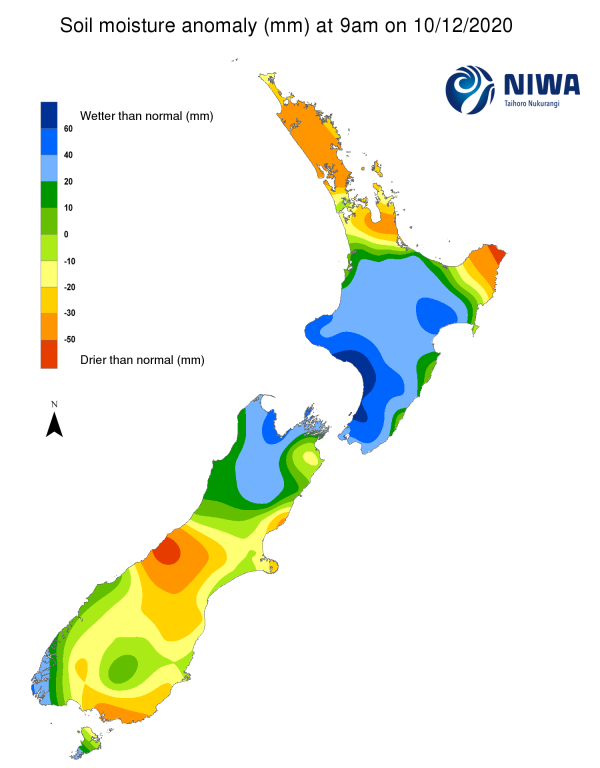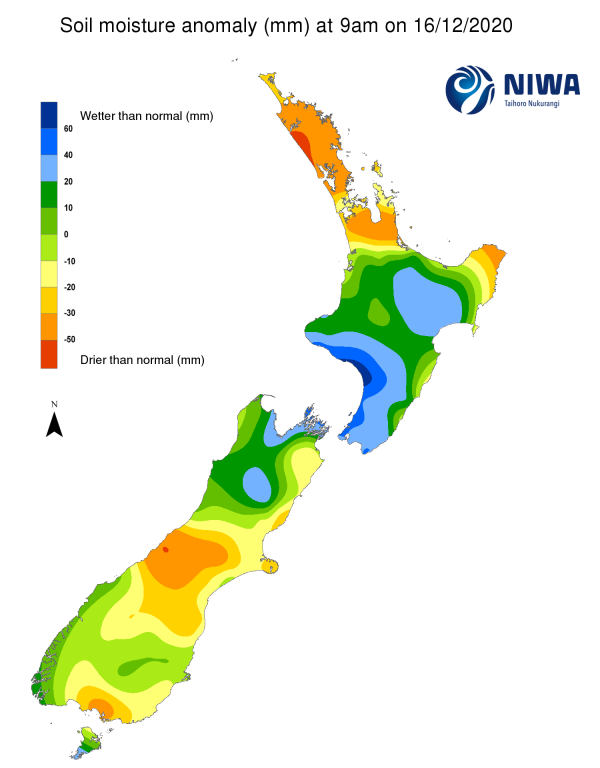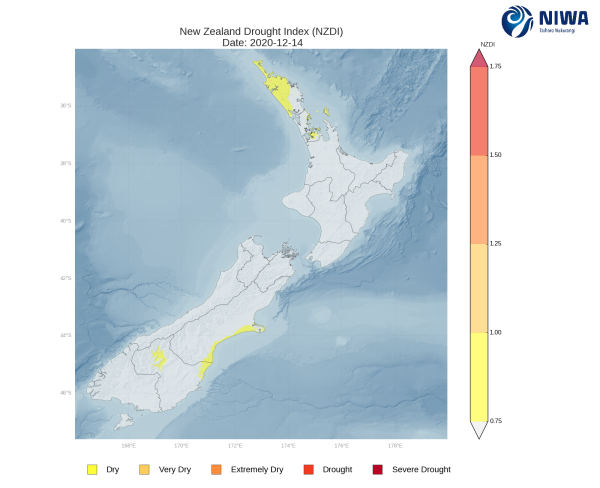A weekly update describing soil moisture patterns across the country to show where dry to extremely dry conditions are occurring or imminent. Regions experiencing significant soil moisture deficits are deemed “hotspots”. Persistent hotspot regions have the potential to develop into drought.
Facts: Soil Moisture
A large area of high pressure overhead led to minimal rainfall nearly everywhere in the North Island during the past week, with most locations receiving less than 5 mm, and some places receiving no rainfall at all. However, parts of Opotiki District received up to 15 mm. This lack of rainfall led to moderate soil moisture decreases nearly everywhere across the North Island. The driest soils across the North Island, when compared to normal for this time of the year, are now found in western Northland. Meanwhile, the wettest soils for this time of the year are located in coastal Manawatu-Whanganui.
Hotspots are currently in place in East Cape, Hauraki District, Aupouri Peninsula, lower Northland and northern Auckland.
In the South Island, widespread rainfall amounts of 25-50 mm were observed in the West Coast, Southland, and parts of Otago. However, only meagre rainfall occurred in Canterbury, Marlborough, Nelson, and parts of Tasman, with amounts generally 5 mm or less. In fact, some locations in Canterbury received no rainfall during the past week. While soil moisture decreases occurred in the upper and eastern South Island, some minor increases were observed in the west and south. The driest soils in the South Island compared to normal for this time of the year are located in central Westland, while the wettest soils for this time of the year are found in Nelson and nearby parts of Tasman and Marlborough.
Hotspots are currently found in coastal Hurunui District, Banks Peninsula, and interior southern Canterbury.
Outlook and Soil Moisture
High pressure will continue to dominate the North Island’s weather over the next several days, leading to little if any rainfall through the upcoming weekend (19-20 December). A few scattered showers may occur during early-to-mid next week, but most locations will only receive minimal rainfall amounts of less than 10 mm.
Due to meagre rainfall expected during the next week, moderate soil moisture decreases are expected for nearly all North Island locations. This will likely result in strengthening and expansion of all current hotspots in the upper North Island and East Cape.
A few showers may affect the West Coast and lower South Island on Friday, but a front will bring more substantial rainfall to these same areas on Saturday. After more light showers in the South Island on Sunday, early-to-mid next week could bring more substantial rain as a couple areas of low pressure move through. Weekly rainfall totals could approach 100 mm in the West Coast, with up to 35 mm in the lower South Island. Once again, smaller rainfall totals will be likely in eastern areas, with 25 mm or less in Marlborough and Canterbury.
Due to expected rainfall, at least small soil moisture increases may be found in western and southern portions of the South Island, while eastern areas may see little change or minor soil moisture decreases. Current hotspots may only change slightly during the next week.
Background:
Hotspot Watch: a weekly advisory service for New Zealand media. It provides soil moisture and precipitation measurements around the country to help assess whether extremely dry conditions are imminent.
Soil moisture deficit: the amount of water needed to bring the soil moisture content back to field capacity, which is the maximum amount of water the soil can hold.
Soil moisture anomaly: the difference between the historical normal soil moisture deficit (or surplus) for a given time of year and actual soil moisture deficits.
Definitions: “Extremely” and “severely” dry soils are based on a combination of the current soil moisture status and the difference from normal soil moisture (see soil moisture maps).
Hotspot: A hotspot is declared if soils are "severely drier than normal" which occurs when Soil Moisture Deficit (SMD) is less than -110 mm AND the Soil Moisture Anomaly is less than -20 mm.
Pictured above: Soil Moisture Anomaly Maps, relative to this time of year. The maps show soil moisture anomaly for the past two weeks.
New Zealand Drought Index (NZDI)
As of 14 December, the New Zealand Drought Index (NZDI) map below shows that drier than normal soils are located in much of Northland, southern Auckland, parts of coastal Canterbury and Otago, and interior Otago. However, meteorological drought is not currently found in New Zealand. Please note: some hotspots in the text above may not correspond with the NZDI map. This difference exists because the NZDI uses additional dryness indices, including one which integrates the rainfall deficit over the past 60 days. Changes are therefore slower to appear in the NZDI compared to soil moisture anomaly maps that are instantaneously updated.




